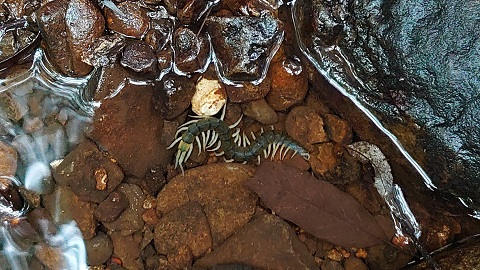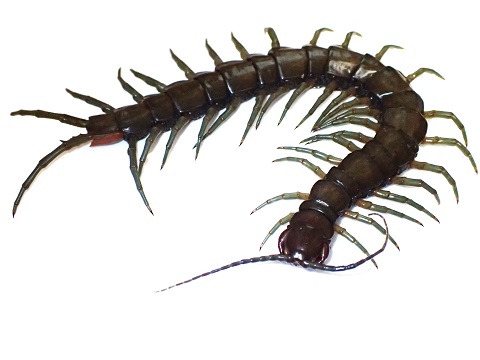Notices
A new species of centipede has been discovered for the first time in Japan in 143 years! Japan's Largest Centipede Lurks in a Mountain Stream, Shining in Jade Green
- April 13, 2021
Overview
Many unknown species are still expected to be discovered on the islands of the Nansei Islands, which are candidates for the World Natural Heritage.
The giant centipede discovered in four areas of Okinawa and Taiwan this time is a giant centipede measuring approximately 20 cm in length and 2 cm in width (about as thick as an adult thumb), and was seen feeding on Japan's largest river shrimp, the Konjin prawn (around 10 cm in length). It is one of the largest new terrestrial arthropod species ever discovered from Okinawa.
This is the third semi-aquatic centipede in the world and the largest species of centipedes found in Japan and Taiwan. Genetic analysis clearly confirms that it is a new species.
This is the first Japanese species in the genus Centipede (which includes the largest species of centipedes) to be described and named by a Japanese.
The scientific name was given to Scolopendra alcyona in reference to its beautiful blue-green (jade) body color and its habit of jumping into rivers. The Japanese name was given to this species as Ryujin giant centipede (Ryujin ohyakusoku), in reference to an Okinawan legend concerning centipedes.
-

Ryujin giant centipede trying to hide itself at the bottom of a mountain stream (Fumiyasu Sato, Director, Kumejima Firefly Museum; photo)
-

A centipede from the Yanbaru region of Okinawa Island (photo by Masashi Tsukamoto, PhD student, Graduate School of Science, Tokyo Metropolitan University)
Background
In order to academically confirm the existence of this species, which had been rumored in the area for some time, a research team consisting of SHIMANO Satoshi (professor at Hosei University), Masashi Tsukamoto (doctoral student at Tokyo Metropolitan University), and Shinpei Hiruta (special adjunct researcher at the National Museum of Nature and Science) was formed to conduct field collaboration, collection and specimen identification. The research team, led by Katsuyuki Eguchi (Associate Professor, Tokyo Metropolitan University) and JHIH-RONG LIAO Liao Ji-young (Research Fellow, National Taiwan University), discovered, described, and named this species.
Details
Centipedes (Lepidoptera) are a class of centipedes with about 150 known species in Japan, and the order Geji-geji (so-called Geji-geji) is a member of Centipedes. Many Centipede species are predatory, with some giant species known to prey on bats overseas.
The Scolopendra alcyona (scientific name: Scolopendra alcyona) is the third semi-aquatic centipede to be described and named in the world. It has the habit of fleeing into the water and hiding when it senses danger to itself. In addition, the centipede has been seen feeding on Japan's largest river shrimp, the Konjin prawn (around 10 cm in length), which lives in the same area. This is the third case of semi-aquatic centipedes in the world, having previously reported one species from Laos, Vietnam, and Thailand in 2016 and one from the Philippines in 2018. It is known to inhabit the deep forests of northern Okinawa Island (Yanbaru region), Kume Island, Iriomote/Ishigaki Island, Tokashiki Island, and Taiwan.
There are five species of centipedes in Japan, including this species, and it has been 143 years since the Germans described two new Japanese species of centipedes, Scolopendra japonica (blue-green centipede) and Scolopendra mutilans (flying centipede), in 1878. It has been 143 years since the German description of the two new species. The discovery of such a huge new species of terrestrial invertebrate in the 21st century is proof that there are still many unknown species on the islands of Okinawa, It is an appeal to the need for comprehensive conservation of biodiversity and ecosystems.
The Ryujin centipede discovered in this study is the largest species (19 cm long and 2.1 cm wide) in Japan and Taiwan in the genus Centipede (a genus that includes the largest species of centipedes in terms of body length). In addition to the characteristics observed in body shape and color, analyses of two gene regions in the nuclear genome and two gene regions in the mitochondrial genome indicate that this is a new species that is distinctly different from the known species.
Because of its beautiful blue-green body color (jade color) and the way it jumps into the river, the species was given the scientific name Scolopendra alcyona, after the Greek goddess Alcyone, like the kingfisher, a bird with a similarly beautiful body color. On the other hand, its Japanese name is Ryujin-ohmu-kade (Ryujin giant centipede), after an Okinawa legend. Long ago, a centipede fell into the ear of the dragon god who lived in the sea, and although the dragon god suffered, when he saw a chicken that quickly ate the centipede, the dragon god became afraid of the centipede and the chicken, and from the Ryukyu Dynasty, pictures of chickens and centipede flags (mokazu flag) have been displayed on ships to pray for safe navigation. We named this species "Ryujin Oomucade" in reference to this legend and in honor of the deep forests of Ryukyu where this species lives.
Although this species is usually found in riparian environments in forests where it does not come into contact with humans, it is dangerous to humans when it bites because of its venomous jaws. This species is highly endangered, and we ask that you watch over it from afar.
Publication information
Journal: Zootaxa
Title: A new amphibious species of the genus Scolopendra Linnaeus, 1758 (Scolopendromorpha, Scolopendridae) from the Ryukyu archipelago and Taiwan. Author:SHO TSUKAMOTO)
Author:SHO TSUKAMOTO, SHIMPEI F. HIRUTA, KATSUYUKI EGUCHI, JHIH-RONG LIAO & SATOSHI SHIMANO
Research collaborators: Futoshi Taira (Asimuri no Sato), Kenshi Sasaki (University Museum of the Ryukyus), Zensho Touyama (Hedona High School, junior), Fumiyasu Sato (Kumejima Firefly Museum, Director), and many others.
DOI: 10.11646/zootaxa.4952.3.3
For inquiries regarding this matter, please contact
(regarding research)
SHIMANO Satoshi, Professor, Center for Natural Science and Technology and Faculty of Intercultural Communication, Hosei University
E-Mail: sim@hosei.ac.jp
Katsuyuki Eguchi, Associate Professor, Department of Life Science, Graduate School of Science, Tokyo Metropolitan University
E-mail: antist@tmu.ac.jp
(regarding each university and institution)
Tokyo Metropolitan Public University Corporation
Public Relations Section, Planning and Public Relations Division, Administration Department, Tokyo Metropolitan University
TEL: 042-677-1806 E-mail: info@jmj.tmu.ac.jp
Public Relations Division, Office of the President, Hosei University
TEL: 03-3264-9240 E-mail: koho@hosei.ac.jp
National Museum of Nature and Science
Research Activities Public Relations Section, Research Promotion and Management Division, Business Administration Department
TEL: 029-853-8984 E-mail: t-shuzai@kahaku.go.jp
Shinpei Hiruta, Part-time Researcher
National Taiwan University
https://sec.ntu.edu.tw/cp_n_58740.html
University Museum of the Ryukyus (Fujukan)
TEL : 098-895-8841 E-mail: fujukan@agr.u-ryukyu.ac.jp

